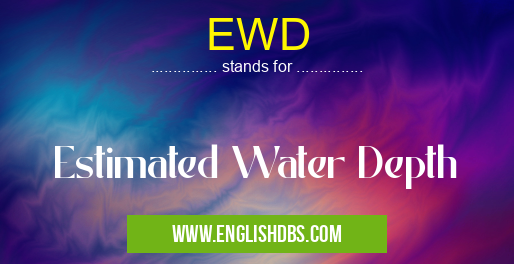What does EWD mean in UNCLASSIFIED
EWD stands for Estimated Water Depth. It is a measurement used in various fields, such as hydrography, navigation, and environmental monitoring, to indicate the approximate depth of water in a specific location.

EWD meaning in Unclassified in Miscellaneous
EWD mostly used in an acronym Unclassified in Category Miscellaneous that means Estimated Water Depth
Shorthand: EWD,
Full Form: Estimated Water Depth
For more information of "Estimated Water Depth", see the section below.
Purpose and Significance
EWD provides valuable information for:
- Navigation: Assisting vessels in determining safe passage by avoiding shallow or obstructed areas.
- Hydrographic Surveys: Creating detailed maps of underwater terrain, including depth measurements.
- Environmental Monitoring: Assessing the water level in lakes, rivers, and other water bodies to monitor changes and protect aquatic ecosystems.
Method of Estimation
EWD is typically estimated using various techniques, including:
- Soundings: Measuring the depth of water using a depth sounder or echo sounder.
- Tide Predictions: Taking into account the influence of tides on water levels.
- Remote Sensing: Using satellite imagery or airborne sensors to estimate water depth based on water color and surface characteristics.
Accuracy and Reliability
The accuracy and reliability of EWD depend on factors such as:
- Data sources: The quality and availability of depth measurements or tide predictions.
- Estimation methods: The techniques used to process and interpret the data.
- Environmental conditions: The presence of factors like waves, currents, or sedimentation.
Applications
EWD finds applications in a wide range of industries and sectors, including:
- Maritime Navigation: Ensuring the safe passage of vessels.
- Oceanography: Studying the physical and chemical properties of oceans.
- Coastal Management: Assessing coastal erosion and sea-level rise.
- Environmental Research: Monitoring water resources and aquatic ecosystems.
Essential Questions and Answers on Estimated Water Depth in "MISCELLANEOUS»UNFILED"
What is Estimated Water Depth (EWD)?
Estimated Water Depth (EWD) is a measurement that indicates the approximate depth of water in a given location. Using factors such as water surface elevation, tide levels, and bathymetric data, EWD provides an estimate of the water depth at a particular point or area.
How is EWD calculated?
EWD is calculated by combining water surface elevation data, which can be obtained from tide gauges or satellite measurements, with bathymetric data that describes the topography of the seafloor. Advanced algorithms and models are used to process this data and estimate the water depth.
Why is EWD important?
EWD is crucial for various marine activities, including navigation, coastal planning, and environmental monitoring. It provides mariners with essential information for safe navigation, helps in understanding tidal patterns, and aids in the modeling of ocean currents and ecosystems.
What are the limitations of EWD?
EWD estimates may have limitations in certain areas or conditions. Factors such as rapidly changing tides, strong currents, or shallow waters can affect the accuracy of the estimations. Additionally, the availability and quality of bathymetric data can impact EWD accuracy.
How can EWD be accessed?
EWD data can be obtained from various sources, including government agencies, oceanographic institutions, and online platforms. These sources often provide data in different formats, such as maps, charts, or numerical values.
Final Words: EWD plays a crucial role in providing approximate information about water depth. By understanding the purpose, significance, methods of estimation, and applications of EWD, users can leverage this measurement to make informed decisions and ensure safety and sustainability in various domains.
EWD also stands for: |
|
| All stands for EWD |
